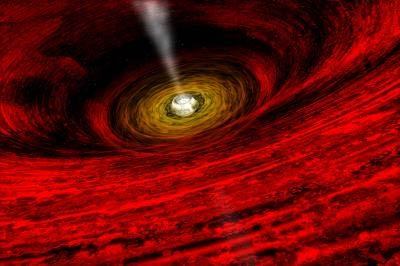Findings Could Put a New Spin on Black Holes

The way that light gets distorted by the warped space-time around black holes soon could help scientists directly detect whether those monsters spin, researchers said.
These findings could shed light on the physics of black holes in more detail than earlier deemed possible.
Gravity is a force that leads bodies like planets and stars to pull not just on matter and light, but on space and time itself. If a massive body is rotating, it swirls the fabric of space-time around it, an effect known as frame-dragging that is even detectable around Earth. Although scientists have conjectured that the black holes such as the one suggested to exist at the center of our galaxy are spinning, no one has any direct evidence yet that they do so.
Black hole spinners
Although black holes absorb light that falls into them, light can escape from nearby black holes, such as rays given off by superhot matter just before it gets sucked into oblivion. According to Einstein's theory of general relativity, packets of light, or photons, can get twisted by the rotating space-time around spinning black holes, much as one might still feel a bit of a pull after stepping off a merry-go-round.
Computer simulations of spinning black holes now reveal just how they might distort photons. Future research to look for such twisted photons could thus uncover how fast black holes are spinning.
"Light acquires kind of a spiral motion that carries information about the distorted space-time around a black hole," study co-author Bo Thidé, a space physicist at the Swedish Institute of Space Physics in Uppsala, told SPACE.com. "You can imagine that the light that approaches us from the black hole is not going in a straight line, but in spirals."
Get the world’s most fascinating discoveries delivered straight to your inbox.
What researchers need now to detect such light "is a big telescope," Thidé said.
The strongest candidate that currently exists is the Very Large Array in New Mexico. Upcoming possibilities include the Atacama Large Millimeter/submillimeter Array in Chile and the Square Kilometer Array planned for either Australia or South Africa.
"This possibility of direct detection of swirling space and time around black holes is one that we think is quite exciting," Thidé said.
Testing physics with black holes
Knowing details about black hole spin can help pin down other features, such as the often considerable uncertainties in their masses. Such results can also test how accurate Einstein's theory of general relativity is, Thidé added.
There could also be more exotic possibilities. Black holes not only suck in light, but also paradoxically could give off tiny amounts of it. Although this so-called Hawking radiation has proven elusive, the fact that it emerges so close to black holes means that it should be highly distorted by frame-dragging and thus recognizable from the rest of the radiation coming from black holes.
As such, it could shed light on both the nature of Hawking radiation and on the physics right next to the so-called event horizon of black holes, from which supposedly nothing can return.
"Why not also see the effects of dark matter on black holes," Thidé asked. "We now have a new tool in our tool chest, and now we have to find out how to use it."
The scientists detailed their findings online Jan. 13 in the journal Nature Physics.
This article was provided by SPACE.com, a sister site of LiveScience.


